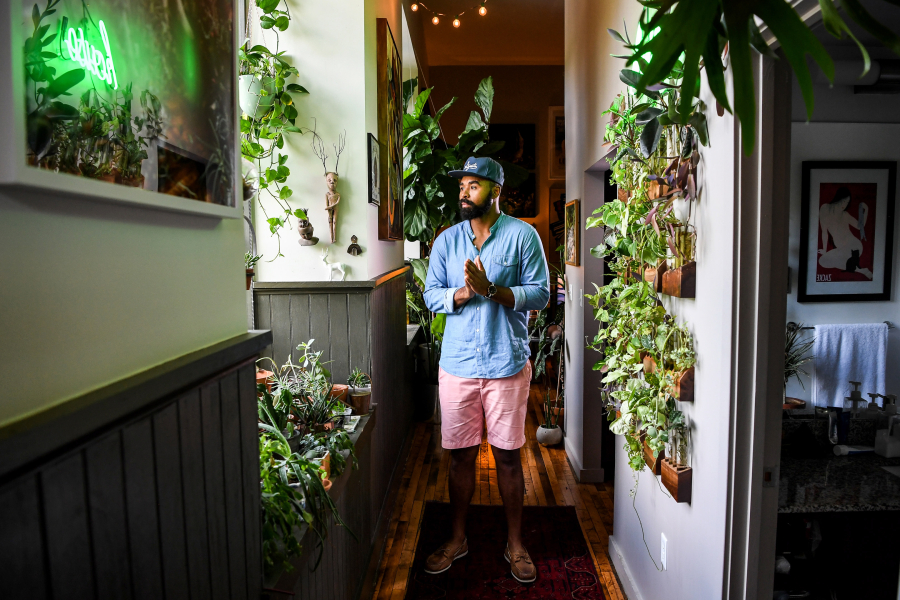On Sunday mornings, Hilton Carter’s girlfriend makes herself scarce from their one-bedroom apartment in an old Baltimore mill.
Carter, who is 6 foot 5 inches, bearded and the sort of man who wears a denim shirt and a ball cap with his peach shorts, begins a four-hour grooming ritual.
Not his own, of course. That would be insane.
The hours when others are sipping bottomless mimosas, that’s when Carter, a 37-year-old artist, feeds and inspects and prunes and otherwise tends to the Great Dane of a fern cascading down above his bed. It’s when he “bathes” the tiny air plants perched like tropical bugs on his geometric mirror. This is when he can fuss over the verdant monstera, trademark Swiss-cheese holes in its sprawling leaves, that sways gently in the breeze coming off the Jones Falls River just outside the window.
There are 180 plants here. This means every Sunday, there are yellowed leaves to pluck away and toss. Bugs to keep an eye out for. The great existential mysteries of light and air and sun to consider.
“There’s a lot of expletives flying, all day,” Carter says of his weekend labor. “It’s just, ‘What is happening to you?! You were fine for the last year in this spot!’ It hurts.”
Greenery has been a motif among the achingly hip for at least three years, when blouses flecked with leaves and palm trees and massive birds of paradise first strutted down the runways at Marc Jacobs and Marni, and then floated all the way down to the Gap.
But suddenly, the tropicalia is finding its way indoors. Even in drab gray concrete jungles such as Baltimore and New York, young people are turning their apartments into “house jungles.”
Others prefer the term “urban rain forest” or the cutesy “jungalow.” In this aspirational landscape, outlandishly and photographically lush is ideal, and filling your home with plants is “urban wilding.” In less enlightened times, we probably would have just called it “decorating.”
Annie Dornan-Smith, a 22-year-old London-based graphic artist, guesses she may have as many as 50 plants in her flat. “They’re not particularly expensive, and it’s another way to have something to look after,” she muses. This summer, she published “House Jungle,” an illustrated guide to selecting and rearing the ubiquitous architectural plants of this trend: the slender and spiky dracaena and areca palms, the birds of paradise, the lanky snake plants and …
“Fiddle-leaf fig,” offers an employee of Little Leaf, a twee plant and paper shop that opened in the winter in Washington, D.C. She nods in the direction of the hot seller, a sprawling bush-like number laden with floaty, almost translucent waxy-green leaves the size of dinner plates.
The fiddle-leaf fig has achieved what is known in the Instagram universe as holy-grail status. But as with Pokemon, the plant-obsessed are collecting them all.
“They’re each your own little baby,” says Joseph Wanek, 31, who lives in a midcentury house in Iowa with his partner, Nick Sellers, and at least 45 plants. “At first Nick was not wanting me to bring them home,” says the prop stylist. “He was saying I was a plant hoarder.”
Nick came around. “It became more and more of an obsession,” the 28-year-old art director confesses.
The buying habits of millennials, naturally, have a way of attracting attention. Shops have become wise to the growing number of novice green thumbs. “This has caught on,” Carter says. “The nurseries have figured this out, the hardware stores have figured this out.”
Of course, some people have always had a ficus around the house. But a faddish interest in houseplants in America seems to perennially blossom and then die out.
“One of the first waves of houseplants was after the Industrial Revolution,” says Tovah Martin, author of several books on the subject, including “The Indestructible Houseplant” and “The Unexpected Houseplant.”
People were building and then moving into cities, she says, and they began to want to establish a sense of — forgive us — rootedness.
Martin has a theory about the houseplant revival of 2017.
In the 1970s, there was Watergate and war and turmoil in the Middle East, and housewives hung ivies, pothos and devil’s backbone from their macrame plant hangers. (“My grandma totally had all these plants,” Sellers says.)
“It’s very cyclical,” Martin says. “I think the current cycle has a lot to do with people hunkering down. A houseplant is therapeutic. It gives you something to nurture.”
There are other factors, of course. As with almost everything these days: Instagram.
Go on, search the hashtag #urbanjungle. Or #monsteramonday. Or #plantgang.
“It’s just nice,” says Dornan-Smith, “when you take pictures of your house, and there is this big sculptural plant in the background.”
Carter’s plant-filled account has 41,300 rabid followers (some of whom message him for plant tips, others asking whether they can just come see his urban jungle in person). A popular blog called The Jungalow also showcases the plant-filled life.
But funny thing about the urban jungle. In all its welcoming Insta-loveliness, there hardly ever seems to be a gardening tool or even a stray speck of potting soil in sight, much less a hair spray bottle now repurposed as unfashionable plant mister. No one ever complains about mites. Few mention four-hour watering sessions. Or yellowing leaves or when a beloved plant-baby meets its ugly — literally, ugly! — end.
“We lose, like, 20 a year,” groans Wanek.
“Some are just supposed to die,” Carter says, pragmatically.



